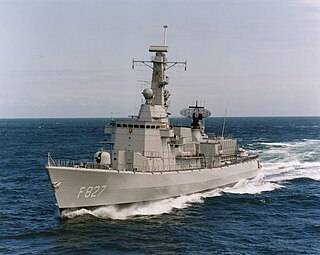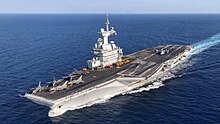
The French Navy, informally La Royale, is the maritime arm of the French Armed Forces and one of the four military service branches of France. It is among the largest and most powerful naval forces in the world, ranking seventh in combined fleet tonnage and fifth in number of naval vessels. The French Navy is one of eight naval forces currently operating fixed-wing aircraft carriers, with its flagship Charles de Gaulle being the only nuclear-powered aircraft carrier outside the United States Navy, and one of two non-American vessels to use catapults to launch aircraft.

Arromanches (R95) was an aircraft carrier of the French Navy, which served from 1946 to 1974. She was previously HMS Colossus (15) of the Royal Navy. She was the name-ship of the Colossus class of light carriers. She was commissioned in 1944, but did not see any action in World War II. She served with the British Pacific Fleet in 1945–46, as an aircraft transport and repatriation ship.

Charles de Gaulle is the flagship of the French Navy. The ship, commissioned in 2001, is the tenth French aircraft carrier, the first French nuclear-powered surface vessel, and the only nuclear-powered carrier completed outside of the United States Navy. She is named after French president and general Charles de Gaulle.

PA2 was a planned aircraft carrier under development by Thales Naval France and DCNS for the French Navy. The design was based on the Queen Elizabeth-class aircraft carriers developed for the Royal Navy. The project was cancelled in the 2013 French White Paper on Defence and National Security.

Leopold I (F930) is a Karel Doorman-class frigate of the Marine Component of the Belgian Armed Forces. Prior to 29 March 2007, the ship was known as HNLMS Karel Doorman (F827). It is one of the two frigates of this class purchased from the Royal Netherlands Navy on 22 December 2005.

Chevalier Paul is a Horizon-class frigate of the French Marine Nationale commissioned in June 2009, the third vessel of the French Navy named after the 17th century admiral Chevalier Paul. The main mission of this type of ship is the escort and protection of a carrier strike group formed around an aircraft carrier, usually Charles de Gaulle or one of the aircraft carriers of the US Navy, or an amphibious operation carried out by amphibious helicopter carriers. The ship's specialty is air traffic control in a war zone, but it can be employed in a wide variety of missions, such as intelligence-gathering, special forces operations, or in protecting less well-armed vessels. Horizon-class frigates such as Chevalier Paul are the most powerful surface combatants that France has ever built. In service since the end of 2011, it bears the pennant number D621. Its namesake is Jean-Paul de Saumeur, better known as Chevalier Paul, a French naval officer born in Marseille in 1598.

Casabianca was a Rubis-class nuclear attack submarine of the French Navy. Laid down in 1981, she was launched in 1984 and commissioned in 1987. She was withdrawn from service in June 2023.

French Navy modernization is pursued on the basis of successive Projet de loi de programmation militaire. These defence modernization plans are formulated on a rolling basis pursuant to strategic, political and budgetary factors and pressures. The latest LPM covers the period 2024 to 2030 and is organized around four strategic priorities: strengthening deterrence, preparation for high intensity operations, protecting interests in all French territories and key domains and strengthening international partnerships.
The Force d'action navale is the 9,600-man and about 100-ship force of surface warships of the French Navy. As of 2018, it is commanded by Vice-Amiral d’Escadre Jean-Philippe Rolland.

Minerve was a diesel–electric submarine in the French Navy, launched in 1961. The vessel was one of 11 of the Daphné class. In January 1968, Minerve was lost with all hands in bad weather while returning to her home port of Toulon.

The Foudre was a French seaplane carrier, the first in history. Her development followed the invention of the seaplane in 1910 with the French Le Canard.

La Fayette was an 11,000-ton Independence-class aircraft carrier that served the French Navy from 1951 to 1963. She was the first French vessel named after the 18th century general Marquis de Lafayette. She was initially USS Langley (CVL-27) serving the United States Navy from 1943 to 1947 before transferring to the French Navy.

Four ships of the French Navy have been named in honour of Armand-Jean du Plessis, Cardinal Richelieu, considered to be one of the founders of the French Navy.

Celebrity Apex is an Edge-class cruise ship operated by Celebrity Cruises, a subsidiary of Royal Caribbean Cruises Ltd. Constructed at Chantiers de l'Atlantique in Saint-Nazaire, France, she is the second vessel in the company's Edge class of ships, following the delivery of her sister ship, Celebrity Edge, in 2018. Due to the COVID-19 pandemic, her debut sailing was from Athens on June 19, 2021 to the Greek Islands.

The COVID-19 pandemic in France has resulted in 38,989,382 confirmed cases of COVID-19 and 167,923 deaths.

The severe acute respiratory syndrome coronavirus 2 (SARS-CoV-2), the cause of the COVID-19 pandemic, was detected on the aircraft carrier USS Theodore Roosevelt in March 2020 while she was at sea. Affected crew members were evacuated and the ship was ordered to Guam. The captain, Brett Crozier, wanted most of the crew to be removed from the ship to prevent the spread of the disease, but his superiors were reluctant. After several days Crozier e-mailed three of his superior officers and seven other Navy Captains, outlining a plan for the ship to be largely evacuated because the virus could not be contained on board. The letter leaked to the press, and the next day the Navy ordered most of the crew to be taken ashore, but the captain was relieved of command by Acting Secretary of the Navy Thomas Modly. Modly's order was controversial, and his later speech to the crew aboard Theodore Roosevelt was criticized. Modly resigned a few days later. By mid-April hundreds of crew members including Crozier had tested positive for the virus, and one had died.

The COVID-19 pandemic spread to many military ships. The nature of these ships, which includes working with others in small enclosed areas and a lack of private quarters for the vast majority of crew, contributed to the rapid spread of the disease, even more so than on cruise ships.

The French Navy is actively planning for a future aircraft carrier and new flagship. It is known in French as Porte-avions de nouvelle génération (PA-NG) for 'new generation aircraft carrier'. Construction of the PANG is expected to begin around 2031 and it is projected to enter service in about 2038; the year the aircraft carrier Charles de Gaulle is due to be retired. The ship will be nuclear-powered and feature the Electromagnetic Aircraft Launch System (EMALS) catapult system.

The bâtiments ravitailleurs de forces, or BRF, are a class of future fleet tankers that are to replace the Durance-class units in French Navy service. Until January 2019, the programme was known as Flotte logistique. First ship of the class completed the first stage of her sea trials in January 2023 and was formally delivered to the French Navy in March to continue her sea trials.


















